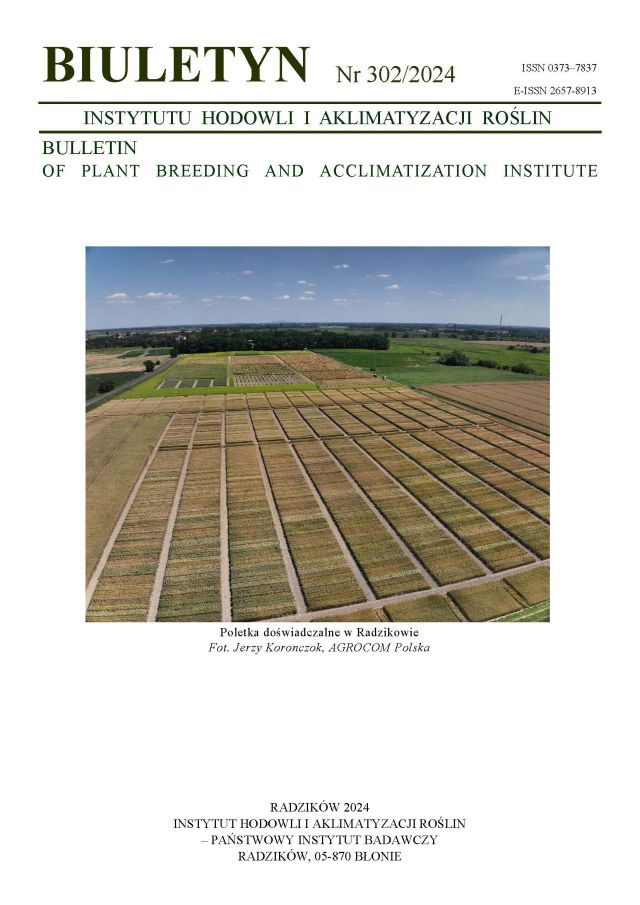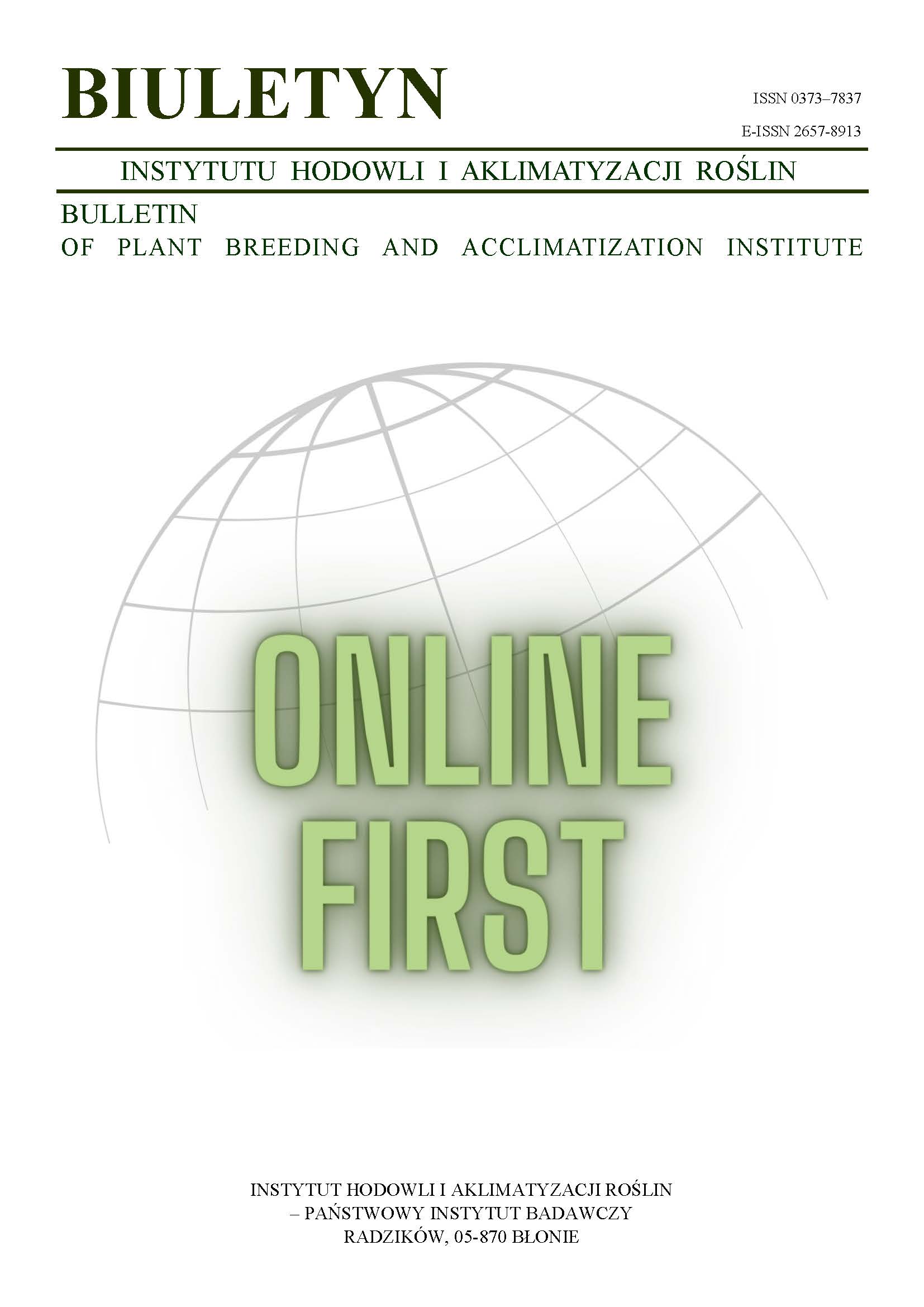Parametry selekcyjne w hodowli nowych odmian pszenicy w aspekcie produkcji żywności funkcjonalnej
Wioletta Monika Dynkowska
wioletta.dynkowska@gmail.comInstytut Hodowli i Aklimatyzacji Roślin — Państwowy Instytut Badawczy, Radzików (Poland)
https://orcid.org/0000-0001-8563-7032
Małgorzata Renata Cyran
Instytut Hodowli i Aklimatyzacji Roślin — Państwowy Instytut Badawczy, Radzików (Poland)
https://orcid.org/0000-0003-0820-6962
Abstrakt
Ziarno pszenicy, podstawowego zboża chlebowego na świecie, jest ważnym źródłem błonnika pokarmowego i przeciwutleniaczy w diecie współczesnego człowieka. Systematyczny wzrost zainteresowania konsumentów żywnością funkcjonalną w Polsce, która może być istotnym elementem profilaktyki i leczenia chorób cywilizacyjnych, zwraca uwagę na potrzebę hodowli polskich odmian pszenicy rekomendowanych do produkcji takiej żywności.
Ziarno 46 linii pszenicy ozimej zostało ocenione pod względem lepkości ekstraktu wodnego, zawartości substancji fenolowych oraz ilości i składu błonnika pokarmowego. Stwierdzono niewielką grupę genotypów, które charakteryzowały się wysoką lepkością ekstraktu ziarna, podstawowego parametru warunkującego, miedzy innymi, spadek poziomu glukozy i cholesterolu we krwi po spożyciu produktów zbożowych. Wykazano dodatnią korelację pomiędzy lepkością ekstraktu ziarna a zawartością arabinoksylanów rozpuszczalnych. Jakkolwiek w wielu przypadkach obserwowano wysoką lepkość ekstraktu ziarna przy niskiej koncentracji arabinoksylanów w ekstrakcie, co wskazywało na nadrzędne znaczenie cech strukturalnych tych polisacharydów w odniesieniu do poziomu lepkości. Szczególne istotna jest długość łańcucha polisacharydowego (masa cząsteczkowa), którą szacowano pośrednio jako lepkość ekstraktu ziarna przypadającą na jednostkę masy arabinoksylanów rozpuszczalnych. Spośród ocenianych form pszenicy tylko dwie z nich wykazywały wysoką lepkość ekstraktu ziarna oraz wysoką koncentrację związków fenolowych.
Genotypy, które łączą w sobie wysoki potencjał lepki i przeciwutleniający oraz charakteryzują się zwiększonym udziałem rozpuszczalnych polisacharydów błonnika pokarmowego, powinny stanowić punkt wyjścia do hodowli nowych odmian pszenicy przeznaczonych do produkcji żywności funkcjonalnej.
Instytucje finansujące
Słowa kluczowe:
arabinoksylany błonnika pokarmowego, błonnik pokarmowy, lepkość ekstraktu ziarna, polisacharydy nieskrobiowe, pszenica ozima, związki fenolowe ogółemBibliografia
Boros, D., Marquardt, R. R., Słomiński, B. A., Guenter, W. 1993. Extract viscosity as an indirect assay for water-soluble pentosan content in rye. Cereal Chemistry, 70 (5): 575–580.
Google Scholar
Chen, M., Guo, L., Nsor-Atindana, J., H. Goff, D., Zhang, W., Mao, J., Zhong, F. 2020. The effect of viscous soluble dietary fiber on nutrient digestion and metabolic responses Ⅰ: In vitro digestion process. Food Hydrocolloids, 107: 105971. https://doi.org/10.1016/j.foodhyd.2020.105971
Google Scholar
Cook, S. I., Sellin, J. H. 1998. Review article: short chain fatty acids in health and disease. Alimentary Pharmacology & Therapeutics, 12 (6): 499–507. https://doi.org/10.1046/j.1365-2036.1998.00337.x
Google Scholar
Cummings, J. H., Pomare, E. W., Branch, H. W. J., Naylor, E., Macfarlane, G. T. 1987. Short chain fatty acids in human large intestine, portal, hepatic and venous blood. Gut, 28: 122–123. https://doi.org/10.1136/gut.28.10.1221.
Google Scholar
Cummings, J. H. 1984. Constipation, dietary fibre and the control of large bowel function. Postgraduate Medical Journal, 60: 811–819. https://doi.org/10.1136/pgmj.60.709.811
Google Scholar
Cyran, M. R., Dynkowska, W. M. 2014. Mode of endosperm and wholemeal arabinoxylans solubilisation during rye breadmaking: Genotypic diversity in the level, substitution degree and macromolecular characteristics. Food Chemistry, 145: 356–364. https://doi.org/10.1016/j.foodchem.2013.07.093
Google Scholar
Cyran, M. R., Dynkowska, W. M., Ceglińska, A., Bonikowski, R. 2021. Improving rye bread antioxidant capacity by bread-making methodology: Contribution of phosphate-buffered saline- and methanol-soluble phenolic phytochemicals with different molecular profiles. Journal of Cereal Science, 100 (5): 103262. https://doi.org/10.1016/j.jcs.2021.103262
Google Scholar
Cyran, M. R., Rakowska, M., Wasilewko, J., Buraczewska, L. 1995. Degradation of dietary fibre polysaccharides of rye in the intestinal tract of growing pigs used as a model animal for studying digestion in humans. Journal of Animal and Feed Sciences. 4 (3): 217–227. https://doi.org/10.22358/jafs/69795/1995
Google Scholar
Cyran, M. R., & Saulnier, L. (2012). Macromolecular structure of water-extractable arabinoxylans in endosperm and wholemeal rye breads as factor controlling their extract viscosities. Food Chemistry, 131(2), 667–676. https://doi.org/10.1016/j.foodchem.2011.09.054
Google Scholar
Cyran, M. R., Ceglińska, A. 2011. Genetic variation in the extract viscosity of rye (Secale cereale L.) bread made from endosperm and wholemeal flour: impact of high-molecular-weight arabinoxylan, starch and protein. Journal of the Science of Food and Agriculture, 91(3), 469–479. https://doi.org/10.1002/jsfa.4208
Google Scholar
Cyran, M. R., Ceglińska, A., Kolasińska, I. 2012. Depolymerization degree of water-extractable arabinoxylans in rye bread: characteristics of inbred lines used for breeding of bread cultivars. Journal of Agricultural and Food Chemistry, 60 (35): 8720–8730. https://doi.org/10.1021/jf301573v
Google Scholar
Dynkowska, W. M. 2019. Rye (Secale cereale L.) phenolic compounds as health-related factors. Plant Breeding and Seed Science, 79, 9–24. https://doi.org/10.37317/pbss-2019-0002
Google Scholar
Dynkowska, W. M. 2020. Rye (Secale cereale L .) arabinoxylans: molecular structure , physicochemicals properties and their resulting pro-health effects. Plant Breeding and Seed Science, 81, 13–32. https://doi.org/10.37317/pbss-2020-0002
Google Scholar
Dynkowska, W. M., Cyran, M. R., Ceglińska, A. 2015. Soluble and cell wall-bound phenolic acids and ferulic acid dehydrodimers in rye flour and five bread model systems: Insight into mechanisms of improved availability. Journal of the Science of Food and Agriculture, 95(5), 1103–1115. https://doi.org/10.1002/jsfa.7007
Google Scholar
Elia, M, Cummings, J.H. 2007. Physiological aspects of energy metabolism and gastrointestinal effects of carbohydrates. European Journal of Clinical Nutrition, 61 (12) Suppl 1: S40-74. https://doi.org/10.1038/sj.ejcn.1602938
Google Scholar
Englyst, H. N., Cummings, J. H. 1984. Simplified method for the measurement of total non-starch polysaccharides by gas-liquid chromatography of constituent sugars as alditol acetates. Analyst, 109 (7): 937–942. https://doi.org/10.1039/AN9840900937
Google Scholar
Fraś, A., Gołębiewska, K., Gołębiewski, D., Boros, D. 2018. Dietary fibre in cereal grains - a review. Plant Breeding and Seed Science, 77: 43–53. https://doi.org/10.37317/pbss-2018-0004
Google Scholar
Gammoh, S., Alu’datt, M. H., Alhamad, M. N., Rababah, T., Ereifej, K., Almajwal, A., Ammari. Z, Al. Khateeb, W., Hussein, N. M. 2017. Characterization of phenolic compounds extracted from wheat protein fractions using high-performance liquid chromatography/liquid chromatography mass spectrometry in relation to anti-allergenic, anti-oxidant, anti-hypertension, and anti-diabetic properties. International Journal of Food Properties, 20 (10): 2383–2395. https://doi.org/10.1080/10942912.2016.1238832
Google Scholar
Henningsson, A., Bjorck, I., Nyman, M. 2001. Short-chain fatty acid formation at fermentation of indigestible carbohydrates. Scandinavian Journal of Nutrition, 45: 165–168. https://doi.org/10.3402/fnr.v45i0.1801
Google Scholar
Hernández, L., Afonso, D., Rodríguez, E. M., Díaz, C. 2011. Phenolic compounds in wheat grain cultivars. Plant Foods for Human Nutrition, 66 (4): 408–415. https://doi.org/10.1007/s11130-011-0261-1
Google Scholar
Hsu, J.-C., Penner, M. H. 1989. Influence of cellulose structure on its digestibility in the rat. The Journal of Nutrition, 119 (6): 872–878. https://doi.org/10.1093/jn/119.6.872
Google Scholar
Ikegami, S., Tsuchihashi, N., Nagayama, S., Harada, H., Nishide, E., Innami, S. 1983. Effect of indigestible polysaccharides on function of digestion and absorption in rats. Japan Society of Nutrition and Food Science, 36 (3): 163–168.
Google Scholar
Izydorczyk, M. S., Biliaderis, C. G., Bushuk, W. 1991a. Comparison of the structure and composition of water-soluble pentosans from different wheat varieties. Cereal Chemistry (USA), 68 (2): 139–144.
Google Scholar
Izydorczyk, M. S., Biliaderis, C. G., Bushuk, W. 1991b. Physical properties of water-soluble pentosans from different wheat varieties’. Cereal Chemistry, 68 (2): 145–150.
Google Scholar
Izydorczyk, M. S., Biliaderis, C. G. 1994. Studies on the structure of wheat-endosperm arabinoxylans. Carbohydrate Polymers, 24 (1): 61–71. https://doi.org/10.1016/0144-8617(94)90118-X
Google Scholar
Izydorczyk, M. S., Biliaderis, C. G. 1995. Cereal arabinoxylans: advances in structure and physicochemical properties. Carbohydrate Polymers, 28: 33–48. https://doi.org/10.1016/0144-8617(95)00077-1
Google Scholar
Jenkins, D. J. A., Marchie, A., Augustin, L. S. A., Ros, E., Kendall, C. W. C. 2004. Viscous dietary fibre and metabolic effects. Clinical Nutrition, Supplement, 1 (2): 39–49. https://doi.org/10.1016/j.clnu.2004.09.007
Google Scholar
Jenkins, D. J., Wolever, T. M., Leeds, A. R., Gassull, M. A., Haisman, P., Dilawari, J., Goff, D. V., Metz, G. L., Alberti, K. G. 1978. Dietary fibres, fibre analogues, and glucose tolerance: importance of viscosity. British Medical Journal, 1 (6124): 1392–1394. https://doi.org/10.1136/bmj.1.6124.1392
Google Scholar
Knudsen, K. E. B. 1997. Carbohydrate and lignin contents of plant materials used in animal feeding. Animal Feed Science Technology, 67 (4): 319–338. https://doi.org/10.1016/S0377-8401(97)00009-6
Google Scholar
Lattimer, J. M., Haub, M. D. 2010. Effects of dietary fiber and its components on metabolic health. Nutrients, 2(12):1266-89. https://doi.org/10.3390/nu2121266
Google Scholar
Liyana-Pathirana, C. M., Shahidi, F. 2006. Importance of insoluble-bound phenolics to antioxidant properties of wheat. Journal of Agricultural and Food Chemistry, 54 (4): 1256–1264. https://doi.org/10.1021/jf052556h
Google Scholar
Lu, Z. X., Walker, K. Z., Muir, J. G., O’Dea, K. 2004. Arabinoxylan fibre improves metabolic control in people with type II diabetes. European Journal of Clinical Nutrition, 58 (4): 621–628. https://doi.org/10.1038/sj.ejcn.1601857
Google Scholar
Maina, N.H., Rieder, A., De Bondt, Y., Mäkelä-Salmi, N., Sahlstrøm, S., Mattila, O., Lamothe, L.M., Nyström, L., Courtin, C.M., Katina, K., Poutanen, K. 2021. Process-induced changes in the quantity and characteristics of grain dietary fiber. Foods, 10: 2566. https://doi.org/10.3390/foods10112566
Google Scholar
Martinant, J. P., Billot, A., Bouguennec, A., Charmet, G., Saulnier, L., Branlard, G. 1999. Genetic and environmental variations in water-extractable arabinoxylans content and flour extract viscosity. Journal of Cereal Science, 30 (1): 45–48. https://doi.org/10.1006/jcrs.1998.0259
Google Scholar
Mateo Anson, N., Havenaar, R., Bast, A., Haenen, G. R. M. M. 2010. Antioxidant and anti-inflammatory capacity of bioaccessible compounds from wheat fractions after gastrointestinal digestion. Journal of Cereal Science, 51 (1): 110–114. https://doi.org/10.1016/j.jcs.2009.10.005
Google Scholar
Nyman, M., Siljestrom, M., Pedersen, B., Knudsen, K. E. B., Asp, N.-G., Johansson, C.-G., Eggum, B. O. 1984. Dietary fiber content and composition in six cereals at different extraction rates. Cereal Chemistry, 61 (1): 14–19.
Google Scholar
Pisoschi, A. M., Pop, A. 2015. The role of antioxidants in the chemistry of oxidative stress: A review. European Journal of Medicinal Chemistry, 97 (5 June): 55–74. https://doi.org/10.1016/j.ejmech.2015.04.040
Google Scholar
Regand, A., Chowdhury, Z., Tosh, S. M., Wolever, T. M. S., Wood, P. 2011. The molecular weight, solubility and viscosity of oat beta-glucan affect human glycemic response by modifying starch digestibility. Food Chemistry, 129 (2): 297–304. https://doi.org/10.1016/j.foodchem.2011.04.053
Google Scholar
Scott, R. W. 1979. Colorimetric determination of hexuronic acids in plant materials. Analytical Chemistry, 51 (7): 936–941. https://doi.org/10.1021/ac50043a036
Google Scholar
Southgate, D. A. T., Durnin, J. V. G. A. 1970. Calorie conversion factors. An experimental reassessment of the factors used in the calculation of the energy value of human diets. British Journal of Nutrition, 24 (2): 517–535. https://doi.org/10.1079/bjn19700050
Google Scholar
Stachowicz, N., Kiersztan, A. 2013. Rola mikroflory jelitowej w patogenezie otyłości i cukrzycy. Postepy Higieny i Medycyny Doswiadczalnej, 67: 288–303.
Google Scholar
Theander, O., Aman, P., Westerlund, E., Andersson, R., Pettersson, D. 1995. Total dietary fiber determined as neutral sugar residues, uronic acid residues, and Klason lignin (the Uppsala method): collaborative study. Journal of AOAC International, 78 (4): 1030–1044.
Google Scholar
Willcox, J. K., Ash, S. L., Catignani, G. L. 2004. Antioxidants and prevention of chronic disease. Critical Reviews in Food Science and Nutrition, 44 (4): 275–295. https://doi.org/10.1080/10408690490468489
Google Scholar
Zielinski, H., Achremowicz, B., Przygodzka, M. 2012. Przeciwutleniacze ziarniaków zbóż. Żywność. Nauka. Technologia. Jakość, 1 (80): 5–26.
Google Scholar
Žilić, S. 2016. Phenolic compounds of wheat. Their content, antioxidant capacity and bioaccessibility. MOJ Food Processing & Technology, 2 (3): 85–89. https://doi.org/10.15406/mojfpt.2016.02.00037
Google Scholar
Autorzy
Wioletta Monika Dynkowskawioletta.dynkowska@gmail.com
Instytut Hodowli i Aklimatyzacji Roślin — Państwowy Instytut Badawczy, Radzików Poland
https://orcid.org/0000-0001-8563-7032
Autorzy
Małgorzata Renata CyranInstytut Hodowli i Aklimatyzacji Roślin — Państwowy Instytut Badawczy, Radzików Poland
https://orcid.org/0000-0003-0820-6962
Statystyki
Abstract views: 463PDF downloads: 282
Licencja
Prawa autorskie (c) 2023 Wioletta Monika Dynkowska, Małgorzata Renata Cyran

Utwór dostępny jest na licencji Creative Commons Uznanie autorstwa – Na tych samych warunkach 4.0 Miedzynarodowe.
Z chwilą przekazania artykułu, Autorzy udzielają Wydawcy niewyłącznej i nieodpłatnej licencji na korzystanie z artykułu przez czas nieokreślony na terytorium całego świata na następujących polach eksploatacji:
- Wytwarzanie i zwielokrotnianie określoną techniką egzemplarzy artykułu, w tym techniką drukarską oraz techniką cyfrową.
- Wprowadzanie do obrotu, użyczenie lub najem oryginału albo egzemplarzy artykułu.
- Publiczne wykonanie, wystawienie, wyświetlenie, odtworzenie oraz nadawanie i reemitowanie, a także publiczne udostępnianie artykułu w taki sposób, aby każdy mógł mieć do niego dostęp w miejscu i w czasie przez siebie wybranym.
- Włączenie artykułu w skład utworu zbiorowego.
- Wprowadzanie artykułu w postaci elektronicznej na platformy elektroniczne lub inne wprowadzanie artykułu w postaci elektronicznej do Internetu, lub innej sieci.
- Rozpowszechnianie artykułu w postaci elektronicznej w internecie lub innej sieci, w pracy zbiorowej jak również samodzielnie.
- Udostępnianie artykułu w wersji elektronicznej w taki sposób, by każdy mógł mieć do niego dostęp w miejscu i czasie przez siebie wybranym, w szczególności za pośrednictwem Internetu.
Autorzy poprzez przesłanie wniosku o publikację:
- Wyrażają zgodę na publikację artykułu w czasopiśmie,
- Wyrażają zgodę na nadanie publikacji DOI (Digital Object Identifier),
- Zobowiązują się do przestrzegania kodeksu etycznego wydawnictwa zgodnego z wytycznymi Komitetu do spraw Etyki Publikacyjnej COPE (ang. Committee on Publication Ethics), (http://ihar.edu.pl/biblioteka_i_wydawnictwa.php),
- Wyrażają zgodę na udostępniane artykułu w formie elektronicznej na mocy licencji CC BY-SA 4.0, w otwartym dostępie (open access),
- Wyrażają zgodę na wysyłanie metadanych artykułu do komercyjnych i niekomercyjnych baz danych indeksujących czasopisma.














